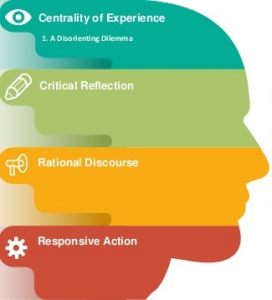Diane Keyes
September 24, 2019
Assignment 1.3: Definitions
Transformative Learning
Introduction
This assignment is to write a parenthetical, sentence, and expanded definition for a term from the author’s field with the objective of developing skill writing definitions with varying levels of detail for a non-technical audience.
The following definitions of ‘transformative learning’ are written for administrators of the network of international high schools I submitted a research proposal to. The project proposes to conduct research on their leadership programs which have been slated for revamping. The administrators have some knowledge of pedagogy, little understanding of this powerful experience noted by participants, and are interested in the elements make one particular program powerful and how they can be implemented in the rest of their programs.
Parenthetical Definition
Based on the preliminary research conducted in September 2018, transformative learning (learning that creates a shift in perspective, identity, belief, value, or worldview) has been identified as a core element of the ‘magical’ experience participants have been reporting at the leadership program in question.
Sentence Definition
Transformative learning is a kind of learning characterized by a change in self-perception, belief, value, action and/or worldview and is often a profound experience.
Expanded Definition
History
Numerous academics from the fields of neurobiology, organizational development, developmental psychology, and education made key contributions to the study of transformative learning. Jack Mezirow initiated the study of transformation in the context of education with his transformative learning theory in the late 1900’s. As summarized in Figure 1, Mezirow purports that transformative learning includes encountering an experience that challenges preconceived ideas of self, other, or world followed by critical reflection and dialogue, resulting in new action. This rational approach focusing on critical self-reflection was expanded by Edward W. Taylor who introduced the role of emotions and the subconscious. Robert Boyd’s inclusion of the change in personality and expansion of consciousness introduced the roles of intuition and creativity in these transformative processes.

FIGURE 1 Overview of Mezirow’s Elements of Transformative Learning
Source: Cradit, N. (2016). Leveraging Transformative Learning Theory to Promote Student Development in Times of Campus Crisis [slideshow]. Retrieved from https://www.slideshare.net/NateCradit/leveraging-transformative-learning-theory-to-promote-student-development-in-times-of-campus-crisis.
Negation
Transformative learning differs significantly from the typical ‘banking’ style employed in classrooms described by Paulo Freire (1970). The banking style is characterized by students’ lack of agency and critical thinking where information is downloaded into the student by the teacher. McWhinney and Markos (2003) call this ‘rote learning’ where learning ‘…adds information and skills without contradicting the prior learnings or raising questions as to the assumptions about what is being taught’ (p. 18). In contrast, transformative learning involves a more horizontal relationship where teachers are more aptly called facilitators and meaning is co-constructed by learners instead of downloaded.
Operating Principles
Groups serve as the container in which transformation can occur. Through dialogue, members meet the limits of their own understanding as they encounter information that challenges or disconfirms their concepts of self, other, or world through hearing the lived experiences and perspectives of others. This dissonance challenges frames of reference, epistemologies, perspectives, and beliefs in what is often an emotionally uncomfortable period of liminality (Schapiro, Wasserman, Gallegos, 2012). Through dialogue and critical reflection with self and other, understandings expand or change to include the disconfirming data.
Required Conditions
Transformative learning takes place in spaces where:
- Relationships provide the container for learning,
- Relationships are horizontal as opposed to hierarchical wherein everyone is a learner and takes part in creating shared meaning,
- There is a sense of shared ownership and agency over the learning space,
- The whole individual is welcomed, including emotions, body, and mind,
- The interests and needs of the learner drive the content and process (Schapiro, 2009).
Three types of transformative group work can be identified based on their developmental outcomes including: personal growth and awareness; relational empathy across differences; and critical systemic consciousness (Schapiro, Wasserman, Gallegos, 2012). Dialogue centering individual perspective and lived experience; social identities and differences within the group; and lived experience of social structures create change in these domains respectively.
Works Cited
Cradit, N. (2016). Leveraging Transformative Learning Theory to Promote Student Development in Times of Campus Crisis [slideshow]. Retrieved from https://www.slideshare.net/NateCradit/leveraging-transformative-learning-theory-to-promote- student-development-in-times-of-campus-crisis.
Freire, P. (1970). Pedagogy of the oppressed. New York: Seabury.
McWhinney, W., & Markos, L. (2003). Transformative education: Across the threshold. Journal of Transformative Education, 1(1), 16-37.
Schapiro, S. (2009). Creating space for transformative learning. In B. Fisher-Yoshida, K. D. Geller, & S. Schapiro, (Eds.), Innovations in transformative learning. New York: Peter Lang.
Schapiro, S., Wasserman, I. L., & Gallegos, P. V. (2012). Group work and dialogue: Spaces and processes for transformative learning in relationships. The handbook of transformative learning: Theory, research, and practice, 355-372.
Leave a Reply